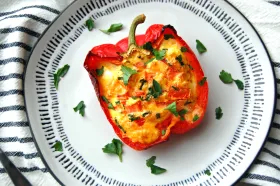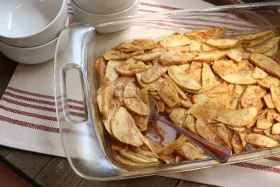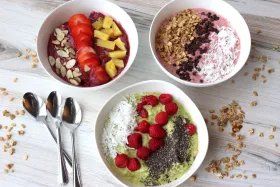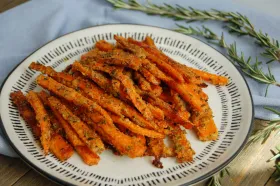Boston Baked Beans
1 lb. Great Northern beans, dry
8 c. water
⅓ c. molasses
⅓ c. brown sugar
3 Tbsp Dijon mustard
8 oz. bacon, cut into half-inch pieces
1 medium onion, diced
Combine the beans and water in an electric pressure cooker. Secure the lid and set on manual; cook for 20 minutes. Allow a natural pressure release, about 15 minutes, then release any remaining pressure. Beans should be mostly cooked through but still firm. Save 1½ cups of liquid and set it aside. Lift the hot inner pot out of the pressure cooker and drain the beans into a colander in the sink carefully to avoid burning yourself. Wash the pot and return it to the pressure cooker.
In a small bowl, whisk together the molasses, sugar, mustard and reserved bean cooking liquid. Set aside. Turn the pressure cooker to sauté and add the bacon. Sauté until some fat is in the bottom of the pot, about five minutes. Then add onion and sauté until it is translucent, about five more minutes. Stir the beans and the seasoning liquid into the pot with the bacon and onions. Secure the lid on the pressure cooker and set manually for 15 minutes. After cooking is complete, allow pressure to release naturally. Serve.
Makes 15 servings. Each serving has 210 calories, 6 g fat, 9 g protein, 29 g carbohydrate, 6 g fiber and 150 mg sodium
7-Bean Soup
½ c. navy beans, dry
½ c. black beans, dry
¼ c. pinto beans, dry
¼ c. kidney beans, dry
¼ c. red lentils, dry.
¼ c. green lentils, dry
1 Tbsp. olive oil
4 carrots, chopped
4 celery stalks, chopped
1 large onion, chopped (about 1½ c.)
1 Tbsp. garlic, minced
8 c. low-sodium vegetable broth
1 tsp. salt
½ tsp. black pepper
½ Tbsp. thyme, dry
½ tsp. sage, dry.
1 (14-oz) can diced tomatoes
2 bay leaves
1 c. kale, chopped
Turn the pressure cooker to sauté function. Add oil and heat until the oil shimmers. Rinse then prepare vegetables as directed. Sauté carrots, celery, onion and garlic until softened and translucent. Add remaining ingredients except kale and cover with the lid seal to lock. Press the manual pressure cook button and set the timer to 20 minutes. Let the pressure release naturally for 10 to 15 minutes. Release any remaining pressure and remove cover. Add kale and cook for five more minutes. Then remove the bay leaves and serve.
Makes 11 servings. Each serving has 170 calories, 2 g fat, 9 g protein, 30 g carbohydrate, 7 g fiber and 430 mg sodium.
Roasted Chickpeas Four Ways
1 (15.5-oz.) can garbanzo beans, drained
Seasoning mix of choice (below)
1 tsp olive or canola oil
Cinnamon sugar seasoning mix
1 Tbsp. granulated sugar
½ tsp. cinnamon
Makes eight servings. Each serving has 5 calories, 0 g fat, 0 g protein, 2 g carbohydrate, 0 g fiber and 0 mg sodium.
Chili lime seasoning mix
1 tsp. chili powder
½ tsp. cumin
½ tsp. salt
¼ tsp. garlic powder
¼ tsp. True Lime (powdered lime)
Makes eight servings. Each serving has 0 calories, 0 g fat, 0 g protein, 0 g carbohydrate, 0 g fiber and 160 mg sodium.
BBQ seasoning mix
1½ tsp. paprika
1 tsp. brown sugar
½ tsp. celery salt
½ tsp. garlic powder
½ tsp. dry mustard
¼ tsp. black pepper
Makes eight servings. Each serving has 5 calories, 0 g fat, 0 g protein, 1 g carbohydrate, 0 g fiber and 55 mg sodium.
Ranch seasoning mix
1 Tbsp. ranch dressing packet
Heat air fryer to 390 F. Drain and rinse chickpeas (no need to dry). Toss with oil and spices. Place the whole batch of chickpeas in the air fryer basket. Cook for 10 to 12 minutes, shaking a few times throughout. When chickpeas are cooked to your liking, remove from air fryer. Store in an open container.
Makes eight servings. Each serving has 5 calories, 0 g fat, 0 g protein, 0 g carbohydrate, 0 g fiber and 85 mg sodium.
Parmesan Rosemary Carrot Fries
3-4 large carrots, peeled
3 Tbsp. olive or canola oil
¼ c. grated parmesan cheese
1 Tbsp. garlic powder
Leaves from 4 sprigs of fresh rosemary, chopped
¼ tsp. salt
¼ tsp. pepper
Oven Directions
Preheat oven to 400 F. Peel and cut the carrots lengthwise to resemble the shape of French fries. Mix olive oil, Parmesan, garlic powder, rosemary, salt and pepper in medium bowl. Add carrots and toss to coat. Place carrots on baking sheet lined with parchment paper and bake for 15 to 20 minutes or until carrots become slightly crispy. Turn carrots over halfway through baking.
Air Fryer Directions
Preheat air fryer to 425 F. Peel and cut the carrots lengthwise to resemble the shape of French fries. Mix olive oil, Parmesan, garlic powder, rosemary, salt and pepper in medium bowl. Add carrots and toss to coat. Spread carrots evenly throughout basket, then air fry at 375 F for 20 minutes. Turn carrots halfway through air frying.
Makes four servings. Each serving has 110 calories, 7 g fat, 3 g protein, 10 g carbohydrate, 2 g fiber and 290 mg sodium.
Falafel*
½ c. parsley leaves, stems removed and chopped
2 green onions, cut into 1-inch pieces
2 garlic cloves, crushed
¼ c. dry bread crumbs, Panko style
1 Tbsp. olive or canola oil
1 tsp. ground cumin
1 tsp. ground coriander
1 tsp. ground turmeric
½ tsp. salt
¼ tsp. ground pepper
¼ tsp. cayenne or chili powder
1 Tbsp. lemon juice
1 tsp. baking powder
1 egg
1 (19-oz) can chickpeas, drained and rinsed (no salt added, if available)
Place chopped parsley, green onion and garlic in a food processor and pulse until just combined, but not a paste. Add breadcrumbs, oil, spices, lemon juice, baking powder and egg and pulse until just combined. This should be a soft mixture. Add chickpeas and pulse ingredients 4 to 6 times, just until combined and roughly chopped. The chickpeas should be roughly broken up and the mixture damp enough to stick together. Spoon a small ball of the mixture and gently flatten into patties, about 2-inches in diameter. Place on a parchment-lined cookie sheet and chill in the freezer for 5 minutes before cooking. In a shallow frypan, pour enough canola oil to cover about ½-inch. Over medium heat, fry patties in small batches, about 3 minutes per side, until crispy on the outside. Top up oil as needed. Serve hot or store in the fridge or freeze between layers of plastic wrap. Reheat in a moderate over for a few minutes before serving.
To air fry instead of pan fry: preheat air fryer to 400 F, then air fry at 350 F for 15 minutes, flipping halfway through.
Makes 18 servings. Each serving has 93 calories, 6 g fat, 2 g protein, 7 g carbohydrate, 1 g fiber
and 88 mg sodium.
Recipe courtesy of https://albertapulse.com/recipe/falafels/
*Falafel are balls or patties made from chickpeas, herbs and/or spices fried in oil. These vegetarian foods often are stuffed in pita bread with vegetables and served with a side of hummus. Falafel are popular as Middle Eastern food sold from street vendors.






















































